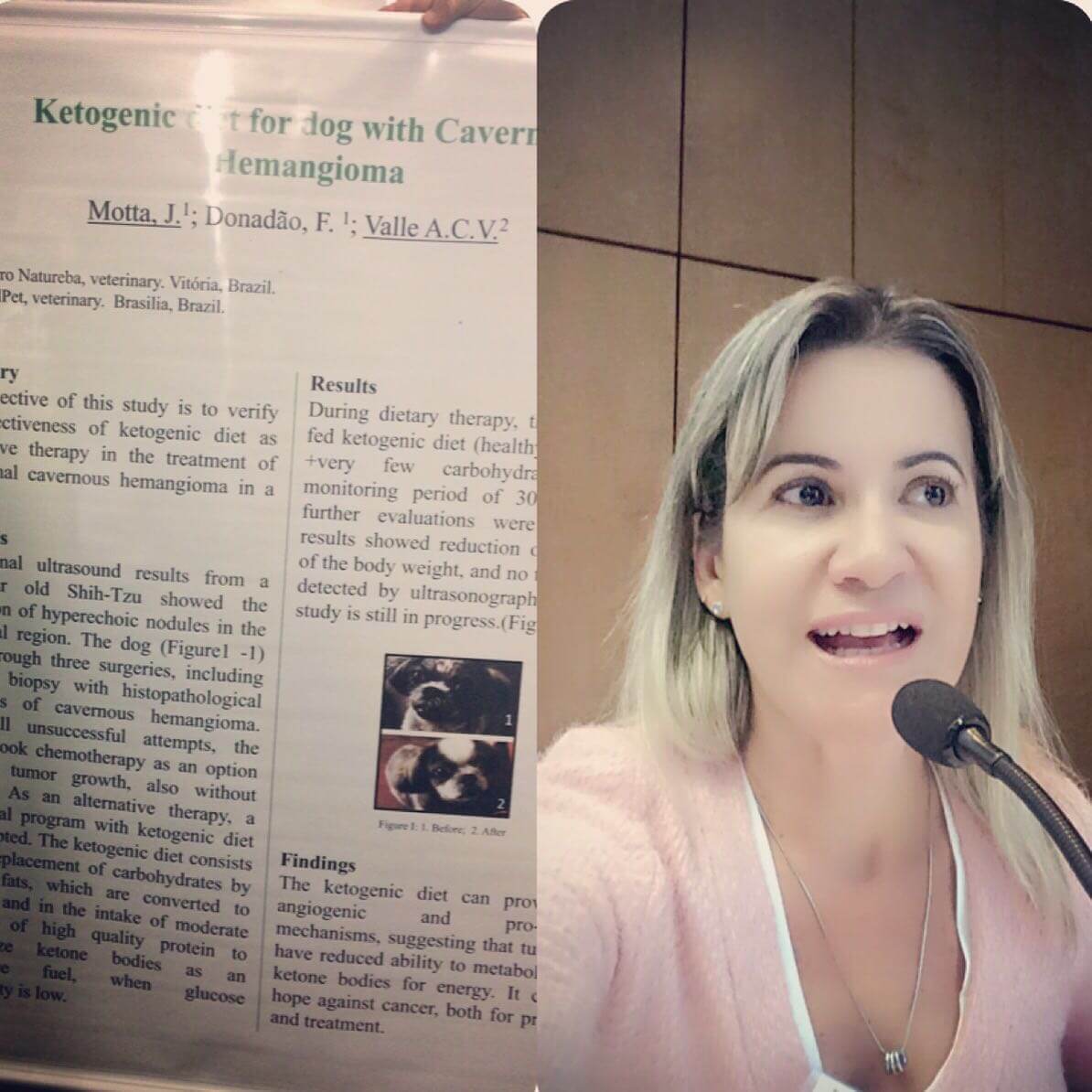Aqui está o resumo do trabalho apresentado no World Congress of Integrative Medicine realizado em Berlim no ano 2017.

Dieta cetogênica no tratamento de Hemangioma cavernoso em cão.
Jacquelyne Motta, Ana Catarina Valle, Fabíola Donadão
Resumo
Objetivo
O objetivo do presente relato de caso, é verificar a eficácia da dieta cetogênica para o tratamento de Hemangioma cavernoso em abdomem de um cão, como uma terapia alternativa para esse tipo de tumor.
Métodos
Cão da raça Shitzu, 4 anos, foi encaminhado à exame de ultrassonografia abdominal onde foi visualizado formações nodulares hiperecogênicas na região umbilical. Esse paciente foi encaminhado à cirurgia para realização de biópsia com diagnóstico histopatológico de Hemangioma cavernoso. Após três cirurgias sem sucesso, optou-se por utilizar quimioterapia para tentar impedir o crescimento tumoral, também sem sucesso. Iniciou-se então, um programa nutricional com dieta cetogênica na qual os carboidratos são substituídos por gorduras saudáveis e quantidades moderadas de proteína de alta qualidade para metabolizar corpos cetônicos como combustível alternativo à glicose.
Resultados
Durante a terapia dietética, o paciente realizou dieta à base de (gordura + poucos carboidratos + proteína) dieta cetogênica. O paciente foi submetido a novos exames ao longo de 8 meses de tratamento, onde constatou-se que peso corporal foi reduzido em cerca de 10% e não foi detectado crescimento do tumor ao exame ultrassonográfico. O presente relato de caso está em andamento.
Conclusões
Observamos que a dieta cetogênica, pode oferecer mecanismos anti-angiogênicos e pró-apoptóticos, uma vez que as células tumorais têm uma reduzida capacidade de metabolizar esses corpos cetônicos. A dieta cetogênica, pode, nesse sentido, oferecer esperança contra o câncer, tanto para a prevenção como para tratamento.

Ketogenic Diet for Dog with Cavernous Hemangioma
Jacquelyne Motta, Ana Cristina Ladeira de Souza, Ana Catarina Valle, Fabíola Donadão
Summary
The objective of this study is to verify the effectiveness of ketogenic diet as adjunctive therapy in the treatment of abdominal cavernous hemangioma in a dog.
Methods
Abdominal ultrasound results from a four-year old Shih-Tzu showed the formation of hyperechoic nodules in the umbilical region.
The dog went through three surgeries, including surgical biopsy with histopathological diagnosis of cavernous hemangioma. After all unsuccessful attempts, the patient took chemotherapy as an option to stop tumor growth, also without success. As an alternative therapy, a nutritional program with ketogenic diet was adopted.
The ketogenic diet consists in the replacement of carbohydrates by healthy fats, which are converted to ketones, and in the intake of moderate amounts of high quality protein to metabolize ketone bodies as an alternative fuel, when glucose availability is low.
Results
During dietary therapy, the patient was fed ketogenic diet (healthy fat + protein + very few carbohydrates) for a monitoring period of 8 months, while further evaluations were made.
The results showed reduction of about 10% of the body weight, and no tumor growth detected by ultrasonography. This case study is still in progress.
Findings
The ketogenic diet can provide anti-angiogenic and pro-apoptotic mechanisms, suggesting that tumor cells have reduced ability to metabolize these ketone bodies for energy. It can offer hope against cancer, both for prevention and treatment.
References:
- Warburg O: On the origin of cancer cells. Science 1956, 123: 309-314. 10.1126/science.123.3191.309View ArticleGoogle Scholar
- Moreno-Sánchez R, Rodríguez-Enríquez S, Marín-Hernández A, Saavedra E: Energy metabolism in tumor cells. FEBS J 2007, 274: 1393-1418. 10.1111/j.1742-4658.2007.05686.xView ArticleGoogle Scholar
- Deberardinis RJ, Sayed N, Ditsworth D, Thompson CB: Brick by brick: metabolism and tumor cell growth. Curr Opin Genet Dev 2008, 18: 54-61. 10.1016/j.gde.2008.02.003View ArticleGoogle Scholar
- Pelicano H, Martin DS, Xu RH, Huang P: Glycolysis inhibition for anticancer treatment. Oncogene 2006, 25: 4633-4646. 10.1038/sj.onc.1209597View ArticleGoogle Scholar
- Chen Z, Lu W, Garcia-Prieto C, Huang P: The Warburg effect and its cancer therapeutic implications. J Bioenerg Biomembr 2001, 39: 267-274.View ArticleGoogle Scholar
- Rodríguez-Enríquez S, Marín-Hernández A, Gallardo-Pérez JC, Carreño-Fuentes L, Moreno-Sánchez R: Targeting of cancer energy metabolism. Mol Nutr Food Res 2009, 53: 29-48. 10.1002/mnfr.200700470View ArticleGoogle Scholar
- Freund E: Zur Diagnose des Carzinoms. Vorläufige Mittheilung. Wien Med Bl 1885, 8: 267.Google Scholar
- Händel M, Tadenuma K: Über die Beziehung des Geschwulstwachstums zur Ernährung und zum Stoffwechsel. II. Mitteilung. Versuche zur Frage der Bedeutung der Kohlenhydrate für das Wachstum des Rattencarzinoms. Z Krebsforsch (J Cancer Res and Clin Oncol) 1924, 21: 288-293.Google Scholar
- Marks PA, Bishop JS: The glucose metabolism of patients with malignant disease and of normal subjects as studied by means of an intravenous glucose tolerance test. J Clin Invest 1957, 36: 254-264. 10.1172/JCI103419View ArticleGoogle Scholar
- Zuijdgeest-van Leeuwen SD, van den Berg JW, Wattimena JL, van der Gaast A, Swart GR, Wilson JH, Dagnelie PC: Lipolysis and lipid oxidation in weight-losing cancer patients and healthy subjects. Metabolism 2000, 49: 931-6. 10.1053/meta.2000.6740View ArticleGoogle Scholar
- Buzzai M, Bauer DE, Jones RG, Deberardinis RJ, Hatzivassiliou G, Elstrom RL, Thompson CB: The glucose dependence of Akt-transformed cells can be reversed by pharmacologic activation of fatty acid beta-oxidation. Oncogene 2005, 24: 4165-4173. 10.1038/sj.onc.1208622View ArticleGoogle Scholar
- Zhou W, Mukherjee P, Kiebish MA, Markis WT, Mantis JG, Seyfried TN: The calorically restricted ketogenic diet, an effective alternative therapy for malignant brain cancer. Nutr Metab (Lond) 2007, 4: 5. 10.1186/1743-7075-4-5View ArticleGoogle Scholar
- Fine EJ, Miller A, Quadros EV, Sequeira JM, Feinman RD: Acetoacetate reduces growth and ATP concentration in cancer cell lines which over-express uncoupling protein 2. Cancer Cell Int 2009, 29: 14.View ArticleGoogle Scholar
- Skinner R, Trujillo A, Ma X, Beierle EA: Ketone bodies inhibit the viability of human neuroblastoma cells. J Pediatr Surg 2009, 44: 212-6. 10.1016/j.jpedsurg.2008.10.042View ArticleGoogle Scholar
- Holm E, Hagmüller E, Staedt U, Schlickeiser G, Günther HJ, Leweling H, Tokus M, Kollmar HB: Substrate balances across colonic carcinomas in humans. Cancer Res 1995, 55: 1373-8.Google Scholar
- Lieb CW: The Effects on Human Beings of a Twelve Months’ Exclusive Meat Diet. JAMA 1929, 93: 20-22.View ArticleGoogle Scholar
- Wilder RM: The effect of ketonemia on the course of epilepsy. Mayo Clin Bulletin 1921, 2: 307-308.Google Scholar
- Kosoff EH: More fat and fewer seizure: diatary therapies for epilepsy. Lancet Neurol 2004, 3: 415-420. 10.1016/S1474-4422(04)00807-5View ArticleGoogle Scholar
- Neal EG, Chaffe H, Schwartz RH, Lawson MS, Edwards N, Fitzsimmons G, Whitney A, Cross JH: The ketogenic diet for the treatment of childhood epilepsy: a randomised controlled trial. Lancet Neurol 2008, 7: 500-506. 10.1016/S1474-4422(08)70092-9View ArticleGoogle Scholar
- Wiznitzer M: From observations to trials: the ketogenic diet and epilepsy. Lancet Neurol 2008, 7: 471-472. 10.1016/S1474-4422(08)70093-0View ArticleGoogle Scholar
- Atkins RC: Dr. Atkins’ diet revolution. The high calorie way to stay thin forever. D. McKay Co, New York; 1972.Google Scholar
- Kirby RK2005. [http://www.aafp.org/online/en/home/clinical/publichealth/nutrition/atkinsdiet.html]
- Samaha FF, Iqbal N, Seshadri P, Chicano KL, Daily DA, McGrory J, Williams T, Williams M, Gracely EJ, Stern L: A low-carbohydrate as compared with a low-fat diet in severe obesity. N Engl J Med 2003, 348: 2074-2081. 10.1056/NEJMoa022637View ArticleGoogle Scholar
- Shai I, Schwarzfuchs D, Henkin Y, Shahar DR, Witkow S, Greenberg I, Golan R, Fraser D, Bolotin A, Vardi H, Tangi-Rozental O, Zuk-Ramot R, Sarusi B, Brickner D, Schwartz Z, Sheiner E, Marko R, Katorza E, Thiery J, Fiedler GM, Blüher M, Stumvoll M, Stampfer MJ, Intervention Randomized Controlled Trial (DIRECT) Group: Weight loss with a low-carbohydrate, Mediterranean, or low-fat diet. N Engl J Med 2008, 359: 229-241. 10.1056/NEJMoa0708681View ArticleGoogle Scholar
- Nebeling LC, Miraldi F, Shurin SB, Lerner E: Effects of a ketogenic diet on tumor metabolism and nutritional status in pediatric oncology patients: two case reports. J Am Coll Nutr 1995, 14: 202-208.View ArticleGoogle Scholar
- Freund E: Über den Einfluß verschiedener Ernährung auf Tumorempfänglichkeit und Tumorwachstum bei Mäusen. Z Krebsforsch (J Cancer Res and Clin Oncol) 1932, 37: 354-361.Google Scholar
- Caspari W: Über den Einfluß der Kost auf das Wachstum von Impfgeschwüren. VI. Mitteilung. Über den Einfluß des Palmitins auf das Geschwulstwachstum. Z Krebsforsch (J Cancer Res and Clin Oncol) 1933, 38: 355-360.Google Scholar
- Zuccoli G, Marcello N, Pisanello A, Servadei F, Vaccaro S, Mukherjee P, Seyfried TN: Metabolic management of glioblastoma multiforme using standard therapy together with a restricted ketogenic diet: Case Report. Nutr Metab (Lond) 2010, 22: 33.View ArticleGoogle Scholar
- Magee BA, Potezny N, Rofe AM, Conyers RA: The inhibition of malignant cell growth by ketone bodies. Aust J Exp Biol Med Sci 1979, 57: 529-539. 10.1038/icb.1979.54View ArticleGoogle Scholar
- Freedland SJ, Mavropoulos J, Wang A, Darshan M, Demark-Wahnefried W, Aronson WJ, Cohen P, Hwang D, Peterson B, Fields T, Pizzo SV, Isaacs WB: Carbohydrate restriction, prostate cancer growth, and the insulin-like growth factor axis. Prostate 2008, 68: 11-19. 10.1002/pros.20683View ArticleGoogle Scholar
- Hardman WE: Dietary canola oil suppressed growth of implanted MDA-MB 231 human breast tumors in nude mice. Nutr Cancer 2007, 57: 177-183. 10.1080/01635580701277445View ArticleGoogle Scholar
- Otto C, Kaemmerer U, Illert B, Muehling B, Pfetzer N, Wittig R, Voelker HU, Thiede A, Coy JF: Growth of human gastric cancer cells in nude mice is delayed by a ketogenic diet supplemented with omega-3 fatty acids and medium-chain triglycerides. BMC Cancer 2008, 30: 122.View ArticleGoogle Scholar
- Aaronson NK, Ahmedzai S, Bergman B, Bullinger M, Cull A, Duez NJ, Filiberti A, Flechtner H, Fleishman SB, de Haes JC, Kaasa S, Klee M, Osboa D, Razavi D, Rofe PB, Schraub S, Sneeuw K, Sullivan M, Takeda F: The European Organisation for Research and Treatment of Cancer QLQ-C30: A quality-of-life instrument for use in international clinical trials in oncology. J Natl Cancer Inst 1993, 85: 365-376. 10.1093/jnci/85.5.365View ArticleGoogle Scholar
- Schag CC, Heinrich RL, Ganz PA: Karnofsky performance status revisited: reliability, validity, and guidelines. J Clin Oncol 1984, 2: 187-93.Google Scholar
- Breitkreutz R, Tesdal K, Jentschura D, Haas O, Leweling H, Holm E: Effects of a high-fat diet on body composition in cancer patients receiving chemotherapy: a randomized controlled study. Wien Klin Wochenschr 2005, 117: 685-692. 10.1007/s00508-005-0455-3View ArticleGoogle Scholar
- Oken MM, Creech RH, Tormey DC, Horton J, Davis TE, McFadden ET, Carbone PP: Toxicity And Response Criteria Of The Eastern Cooperative Oncology Group. Am J Clin Oncol 1982, 5: 649-655. 10.1097/00000421-198212000-00014View ArticleGoogle Scholar
- Fayers PM, Aaronson NK, Bjordal K, Groenvold M, Curran D, Bottomley A, EORTC Quality of Life Group 2001.
- Holm S: A simple sequentially rejective multiple test procedure. Scand J Statistics 1979, 6: 65-70.Google Scholar
- Mosek A, Natour H, Neufeld MY, Shiff Y, Vaisman N: Ketogenic diet treatment in adults with refractory epilepsy: A prospective pilot study. Seizure 2007, 18: 30-33.View ArticleGoogle Scholar
- Jones LW, Demark-Wahnefried W: Diet, exercise, and complementary therapies after primary treatment for cancer. Lancet Oncol 2006, 7: 1017-26. 10.1016/S1470-2045(06)70976-7View ArticleGoogle Scholar
- Ernst E: The role of complementary and alternative medicine in cancer. Lancet Oncol 2000, 1: 176-80. 10.1016/S1470-2045(00)00031-0View ArticleGoogle Scholar
- Brown AJ: Low-carb diets, fasting and euphoria: Is there a link between ketosis and gamma-hydroxybutyrate (GHB)? Med Hypotheses 2007, 68: 268-271. 10.1016/j.mehy.2006.07.043View ArticleGoogle Scholar
- Nuttall FQ, Ngo A, Gannon MC: Regulation of hepatic glucose production and the role of gluconeogenesis in humans: is the rate of gluconeogenesis constant? Diabetes Metab Res Rev 2008, 24: 438-458. 10.1002/dmrr.863View ArticleGoogle Scholar
- Holroyde CP, Gabuzda TG, Putnam RC, Paul P, Reichard GA: Altered glucose metabolism in metastatic carcinoma. Cancer Res 1975, 35: 3710-3714.Google Scholar
- Beliveau R, Gingras D: Krebszellen mögen keine Himberen (Les aliments contre le cancer). München: Kösel-Verlag; 2008.Google Scholar
- Turan S, Omar A, Bereket A: Comparison of capillary blood ketone measurement by electrochemical method and urinary ketone in treatment of diabetic ketosis and ketoacidosis in children. Acta Diabeto 2008, 45: 83-5. 10.1007/s00592-008-0026-yView ArticleGoogle Scholar
- Adam-Perrot A, Clifton P, Brouns F: Low-carbohydrate diets: nutritional and physiological aspects. Obes Rev 2006, 7: 49-58. 10.1111/j.1467-789X.2006.00222.xView ArticleGoogle Scholar
- Gardner CD, Kiazand A, Alhassan S, Kim S, Stafford RS, Balise RR, Kraemer HC, King AC: Comparison of the Atkins, Zone, Ornish, and LEARN diets for change in weight and related risk factors among overweight premenopausal women: the A TO Z Weight Loss Study: a randomized trial. JAMA 2007, 297: 969-977. 10.1001/jama.297.9.969View ArticleGoogle Scholar
- Berquin IM, Edwards IJ, Chen YQ: Multi-targeted therapy of cancer by omega-3 fatty acids. Cancer Lett 2008, 269: 363-377. 10.1016/j.canlet.2008.03.044View ArticleGoogle Scholar
- Colomer R, Moreno-Nogueira JM, García-Luna PP, García-Peris P, García-de-Lorenzo A, Zarazaga A, Quecedo L, del Llano J, Usán L, Casimiro C: N-3 fatty acids, cancer and cachexia: a systematic review of the literature. Br J Nutr 2007, 97: 823-831. 10.1017/S000711450765795XView ArticleGoogle Scholar
- Hardman WE: (n-3) fatty acids and cancer therapy. J Nutr 2004,134(12 Suppl):3427S-3430S.Google Scholar
- Gutt CN, Brinkmann L, Mehrabi A, Fonouni H, Müller-Stich BP, Vetter G, Stein JM, Schemmer P, Büchler MW: Dietary omega-3-polyunsaturated fatty acids prevent the development of metastases of colon carcinoma in rat liver. Eur J Nutr 2007, 46: 279-285. 10.1007/s00394-007-0662-yView ArticleGoogle Scholar
- Fearon KC, Borland W, Preston T, Tisdale MJ, Shenkin A, Calman KC: Cancer cachexia: influence of systemic ketosis on substrate levels and nitrogen metabolism. Am J Clin Nutr 1988, 47: 42-48.Google Scholar
- Fine EJ, Segal-Isaacson CJ, Feinman R, Sparano J: Carbohydrate restriction in patients with advanced cancer: a protocol to assess safety and feasibility with an accompanying hypothesis. Commun Oncol 2008, 5: 22-26.View ArticleGoogle Scholar
- Clinical trials homepage. registration numbers: NCT00575146, NCT00444054, NCT00932672, NCT01092247 [http://clinicaltrials.gov]



